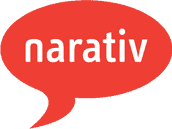As the push for greater diversity, equity, and inclusion in the business world grows, more companies are searching for organic ways to make those improvements within their own organizations. “Boost DEI” can feel like a pretty vague directive—especially for companies that have never put specific efforts toward diversity in the past. Many companies want to do their best with the new measures but aren’t quite sure of the best approach to make the biggest impact.

At Narativ, we believe that leveraging the power of storytelling is an extremely effective approach to issues like access and inclusion that require the elevation of marginalized voices. After all, what better way to amplify the voice of a community than to simply let them tell their stories?
Why Stories Matter: The Origin of Narativ
Our certainty about the use of stories to boost DEI comes from the earliest origins of our company with the experiences of our co-founder Murray Nossel. Murray learned firsthand the power stories can have to facilitate change for marginalized people back in the early 90s during the height of the HIV/AIDS epidemic.
At the time, there were no treatments for AIDS and there was little effort from legislators to answer pleas from the affected communities to direct more funding toward the medical research and healthcare they desperately needed. The people most heavily affected by the epidemic were people of color and members of the LGBTQ+ community—demographics who were already struggling to make their voices heard. Conditions were grim, and people were dying.
This was the challenge Murray found himself facing in his employment as a social worker during this time. His patients were all people suffering from AIDS, and he realized he needed to give them a way to share their lives and experiences with others before they died. So he started a weekly story group to allow them to share with each other.
Before long, his patients asked if he could record the stories so their loved ones could hold onto their stories after they were gone.
When the state of New York began threatening cutbacks to services for people with AIDS, the patients from Murray’s story group began leaving their recorded stories on the desks of the legislators so they could see and know the people who would be hurt by the measures. Their stories proved to be a vital tool in preventing the cutbacks from being made.
These stories gave them a voice where previously they had none.
Bringing it Back to the Office
The conditions in your company are probably nowhere near as dire as New York in the 90s, but the principle can still be applied to boost DEI. Not only that, it can help to make diversity initiatives far more meaningful for everyone involved. So what exactly can storytelling do for marginalized voices?
Increase Visibility
Allowing people the space to speak is one thing, but the best way to get others to truly listen and understand is to tap into the innate human desire to learn and connect through stories. When access and inclusion efforts involve an invitation for people to share stories that illustrate the human experience of being a part of their community, it can make it far easier for marginalized voices to catch the attention of those who may have not otherwise paid attention.
Improve Self-Esteem
Especially in the business world, people from communities that aren’t being heard are often used to their concerns being brushed off, which can damage their confidence in their own voice. When these voices are given a platform to speak about their experiences in a setting where people are sure to listen closely and take their stories to heart, it can restore that lost confidence.
Increase Social Awareness
It’s human nature to form in-groups and generalizations about people from communities outside of ours. Stories break down those walls and make people more willing to have their biases challenged and their understanding of other communities shifted. The more often we do this, the more likely everyone in a diverse group will be to understand the unique societal challenges faced by each member.
Foster Empathy
One thing stories do incredibly well is place the listener in the shoes of the teller. The experience of being excluded is difficult to grasp for those who haven’t experienced it, but if they can live the experience through the eyes of the storyteller, the path to greater empathy becomes clear and open.
Boost DEI by Facilitating Storytelling
Introducing storytelling to the fabric of a workplace might seem tricky, but there are a few ways to establish the practice to make it feel more natural.
The first and best thing you can do is create a dedicated time and space for the telling of stories. Whether that means holding a specific storytelling meeting every week or changing the structure of existing meetings to allow for open sharing of thoughts and experiences, having a specific time to meet and share will get people thinking more about what stories they ought to share throughout the week.
A good way to prime the pump on the sharing of personal experiences is for leadership to make a habit of sharing their own personal stories. The more open and vulnerable leaders are willing to be with these stories, the more willing members of their team will be to likewise share when the time comes.
As a leader working to help boost DEI in their company, it can be as simple as inviting diverse hires and members of historically excluded communities in your office to share personal stories directly. Ask about their upbringing, their heritage, and things that worry them when they come into a new workplace. Be empathetic and open to listening and asking clarifying questions no matter how much their story may challenge your worldview. It will be far easier to identify how to improve access and inclusion within your company if you can see into the lives and struggles of employees whose voices have stayed traditionally stayed in the background.
Amplifying Voices Organically
Stories are always the most organic means of sharing diverse experiences in ways that can be understood by everyone. Dedicated story training can especially help to guide and shape employee stories into a powerful force for understanding and change. Every workplace can benefit from the stories that come from a space dedicated to the shaping and amplifying of every voice that comes to the table.
Figuring out how to best amplify marginalized voices can be tricky, but when you bring storytelling into the mix, those voices amplify themselves.
If you would like to learn more about how a Narativ storytelling training can help boost DEI in your workplace, visit us here to explore our services or schedule a consult with our CEO, Jerome Deroy.
At Narativ, we are committed to helping you become better leaders. This fall, we are offering a special 3-part “Leading with Story” workshop series, September 7, 14, and 21. You won’t want to miss this!



